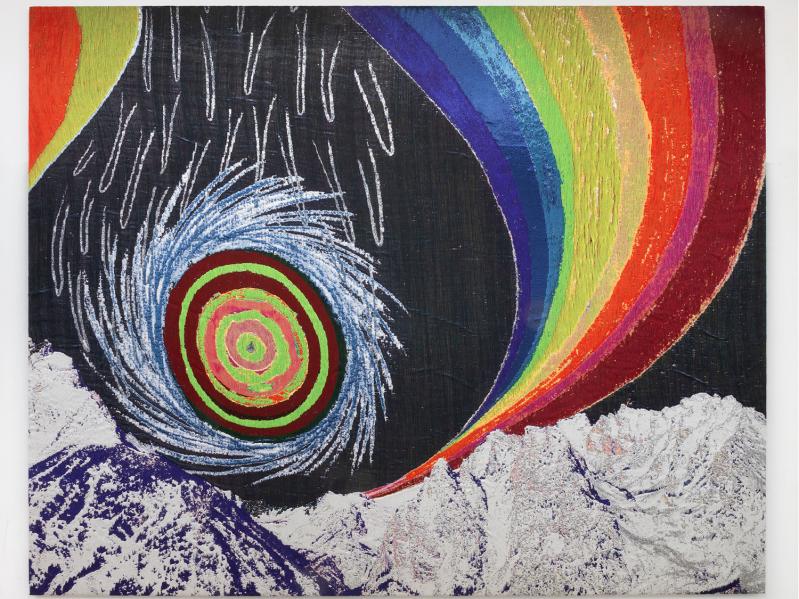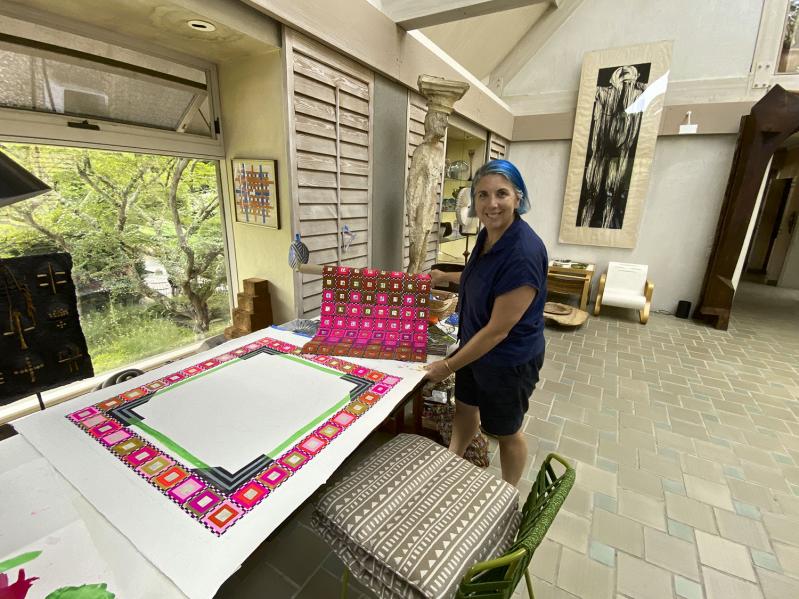Liz Collins is on a roll. Considering her career of working between art and design, with emphasis and expertise in textile media, it’s no surprise she has been selected this year as the first artist in residence at LongHouse Reserve in East Hampton.
The format she developed with Carrie Rebora Barratt, LongHouse’s executive director, is low-residency, which is a good thing, because she has already had to make several trips to Venice, where her two massive layered jacquard wall-works, “Rainbow Mountains Moon” and “Rainbow Mountains Weather,” each 10 by 16 feet, are currently on view in the central pavilion of the Giardini as part of that city’s biennale.
Ms. Collins is also included in “Woven Histories: Textiles and Modern Abstraction,” a traveling exhibition organized by Lynne Cooke that just left the National Gallery of Art in Washington, D.C., before moving on to the National Gallery of Canada in Ottawa and then the Museum of Modern Art in New York.
And a solo midcareer retrospective will open next year at the museum of the Rhode Island School of Design in Providence, where she earned B.F.A. and M.F.A. degrees and taught for 10 years.
It has been a long and somewhat winding road that began in Alexandria, Va., where she was exposed to art from a very young age. “My mother was an art lover, and we lived near the Smithsonian and the National Gallery, where I went as a kid,” she said during a conversation at LongHouse.
Her parents and grandparents were very “resourceful, D.I.Y. people. On both sides there were people making things with cloth.” Even her father, a Navy
captain who moved away from the family when she was 4, made sails with an industrial sewing machine.
After earning her B.F.A. in textiles in 1991, she moved to New York and worked at a company that made woven textiles for fashion. “I was a junior designer, working in the weave studio, doing a lot of hand-woven swatches to develop fabrics for industrial production.”
After a year and a half, she began to wonder if she was an artist or designer, and after a brief period of freelancing she returned to Providence, where she and a friend opened a store. She also, during the mid-1990s, began to make hand-knit clothing.
She returned to RISD and earned an M.F.A. in 1999 “with the idea that I would do R and D for a knitwear business.” She spent the next four years designing clothing, which was carried by Barneys. She also came to the attention of two brothers whose company, Mao Public Relations, had connections to all the stylists, model agents, and editors.
“I was breaking rules with knitting and doing all this innovative stuff, so they recognized it was exciting work. My clothing was in their showroom, and people would borrow it for shoots.”
But because the fashion cycle moves so fast, she decided in 2003 to take a break, and before long landed a tenure-track teaching position at RISD. “I was making a significant salary for the first time, and I realized I didn’t have to sell anything anymore, I could do experimental work and pursue the ideas that had started to surface.”
It has been onward and upward ever since. In 2005 she created “Knitting Nation,” which began as a performance and site specific installation on Governors Island as part of “The Muster,” a public art event conceived by the artist Allison Smith.
Ms. Collins mustered a troupe of knitters who donned uniforms and worked in unison on manually operated knitting machines to create a massive knit American flag that covered the ground and was dirtied, stepped on, and defaced, in part a reflection of Ms. Collins’s views on the Iraq war.
But the political component was secondary to other issues, specifically, how humans interact with machines, global manufacturing, and, in Ms. Collins’s words, “laying bare the toil of physical labor that is required with machines to make fabric and clothing. It was also a happening, a cacophony that at the time I loved.”
Fifteen iterations of “Knitting Nation” happened over the next 11 years, including one commissioned for ICA Boston, one at the Tang Teaching Museum in Saratoga Springs, N.Y., and one at the Museum of Art and Design in New York City.
“I like to say that working in textiles for me is yarn, pattern, and fabric.” About the importance of patterns to her, she said, “It’s something about systems, systems of repetition, and how diverse those can be, and the idea that you can take one thing and repeat it next to itself and on top of itself and it becomes this bigger expanse of visual experience that transcends the unit.”
The creation of entire rooms involving furniture, fabric, and artwork was a logical extension of her interest in the possibilities of repetition. Her first, “Sitting Room,” was a site-specific installation created in 2014 at an art gallery in Provincetown, Mass.
“I was doing a lot of painting of geometric abstract patterns. I wanted to have the artwork be in dialogue with the room, and I wanted to do a rug and curtains and wallpaper. I wanted to have the imagery I was working with in the two-dimensional work translate into interior textiles and also lighting and furniture.”
Ms. Collins created a particularly breathtaking environment in 2019 at the Rossana Orlandi Gallery in Milan. In partnership with Sunbrella, a textile manufacturer, and Ligne Roset, a French furniture brand, she transformed three rooms into “Summit Suite,” creating rugs, wall-to-wall carpeting, wall coverings, furniture fabrics, light fixtures draped in fabric, and framed artworks.
In October 2022 Ms. Collins had a mid-career retrospective at Touchstones Rochdale, a gallery and museum in England. The centerpiece was “Promised Land,” a massive and dramatic work of silk and polyester fabric whose identical pieces cascaded from the gallery wall.
The recurring image was “a stylized mountain range with the jagged sky. I was trying to work with the scale possibilities of industrial production, making these 35-foot-long panels.”

The image of a mountain range appears again in her two large tapestries on view in Venice. A lightning wheel descends from the sky like a spinning cyclone, and a moon-like orb suggests the geometric abstractions of Sonia Delaunay, according to a text by Lex Morgan Lancaster, an art historian and curator.
“I’m moving into a new place that’s more pictorial,” said Ms. Collins. The motif of the Venice pieces reappears in “Rainbow Mountain: Storm,” a 13-foot-long woven textile recently shown at the Candice Madey Gallery on the Lower East Side, which represents her work.
Ms. Collins was introduced to Ms. Barratt at LongHouse by Sherri Donghia, a board member there with whom she has worked in the past. “We started talking about the idea of an artist in residence, because this place is so full of inspiration that it kind of demands an artist’s response.”
As the idea developed, it would not be a conventional live-in residency. Instead, artists would make regular visits to the site, be inspired, develop work, and do some programming, all the while remaining based in their home studio.
“I decided as the inaugural artist in residence I wanted to come up with something that my successors could do too, which is an artist’s edition that could be sold as some kind of fund-raiser. I love scarves, so I’m doing a print edition that is inspired by the Hermes scarves that are squares and have intricate imagery.”
In her drawing-in-progress for the scarf, the border she has created is based on Larsen’s celebrated Magnum fabric. Another element from LongHouse is the L-shape sign at the venue’s entrance, which she has positioned at the scarf’s four corners. Other LongHouse components she has in mind are Will Ryman’s “The LongHouse 6,” a monumental sculpture of red roses visible from her studio there, and Dale Chihuly’s cobalt spikes. In addition to that project, she will have work on view at LongHouse in September.
“I’m pinching myself every time I’m here, because between the nature and the architecture and the objects and the textiles, it’s such a rarefied environment.”




